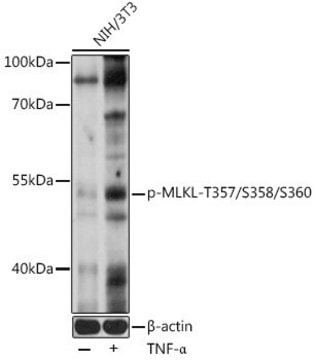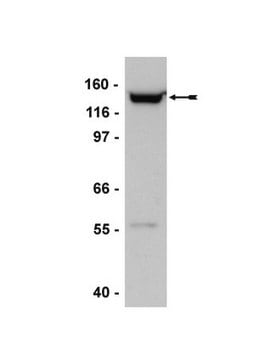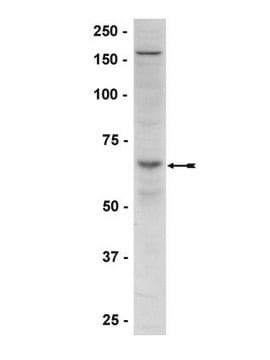15-115
AMPK Pathway Explorer Antibody MiniPack
1 mg/mL, Upstate®
Sinónimos:
AMP-Activated Protein Kinase
About This Item
Productos recomendados
origen biológico
rabbit
Nivel de calidad
forma del anticuerpo
purified antibody
tipo de anticuerpo
primary antibodies
clon
polyclonal
reactividad de especies
rat (07-350SP, 07-363SP, 07-681SP), mouse (07-350SP), human (07-350SP, 07-363SP, 07-681SP)
fabricante / nombre comercial
Upstate®
concentración
1 mg/mL
técnicas
activity assay: suitable (kinase and phosphatase)
western blot: suitable
Nº de acceso UniProt
Condiciones de envío
dry ice
Información sobre el gen
human ... PRKAA1(5562)
mouse ... Hsf3(245525)
Descripción general
Each Pathway Explorer Antibody Minipack contains three related antibodies as part of a signaling cascade or a combination of total and phosphorylated forms of key signaling targets. Each of the three antibodies are 30% the original pack size. Full size versions of each of the Pathway Explorer antibodies are available for sale individually under the same catalog number with the removal of “SP” off of each one (e.g. 05-591SP can be ordered as 05-591).
AMPK:
AMP-activated protein kinase (AMPK) is a metabolic and stress-sensing kinase that regulates homeostasis, and a key target for treating Type 2 diabetes and obesity. AMPK exists as a heterotrimeric complex comprised of catalytic alpha subunits (62 kDa) and non-catalytic beta and gamma subunits. Alpha subunit has at least two isoforms (alpha 1 and alpha 2) which differ in their subcellular localization and AMP-dependence. AMPK is phosphorylated by upstream kinases, AMPK Kinase (AMPKK) and LKB1 which results in its activation. Active AMPK regulates metabolism by phosphorylating rate-limiting enzymes in metabolic pathways and controlling gene expression. Phosphorylation of threonine 172 in the activation loop of the alpha subunit is a key determinant of AMPK activity.
*See full size versions for corresponding references.
Especificidad
07-363SP: AMP-Activated Protein Kinase alpha 2 (AMPKα2).
07-350SP: AMPKα1
Varies. See individual Data Sheets
Inmunógeno
Aplicación
Signaling
Apoptosis & Cancer
Insulin/Energy Signaling
Envase
Componentes
07-363SP Anti-AMPKα2; 60 µg
07-681SP Anti-phospho-AMPKα (Thr172); 60 µg
Calidad
Western Blot Analysis:
0.5-2 μg/mL of this lot detected phospho-AMPK α in RIPA lysates from overnight serum starved HEK293 cells and partially purified rat liver AMPK. Signal was reduced after treatment of lysate with λ-phosphatase.
07-363SP: Routinely evaluated by immunoblot in a rat liver preparation.
Western Blot Analysis:
1-2 μg/mL of this lot detected AMPK α2 in a rat liver preparation.
07-350SP: Routinely evaluated by immunoblot in RIPA lysates from non-stimulated A431 cells.
Western Blot Analysis:
0.5-2 μg/mL of this lot detected AMPK α1 in RIPA lysates from non-stimulated A431 cells.
Descripción de destino
Forma física
Almacenamiento y estabilidad
Handling Recommendations: Upon receipt, and prior to removing the cap, centrifuge the vial and gently mix the solution. Aliquot into microcentrifuge tubes and store at -20°C. Avoid repeated freeze/thaw cycles, which may damage IgG and affect product performance. Note: Variability in freezer temperatures below -20°C may cause glycerol-containing solutions to become frozen during storage.
Nota de análisis
For 07-681SP use HEK293 cells or rat liver AMPK.
For 07-363SP use Rat liver preparation.
For 07-350SP use A431cell lysate, or lysate of HeLa cells treated with heat shock.
Información legal
Cláusula de descargo de responsabilidad
Not finding the right product?
Try our Herramienta de selección de productos.
Código de clase de almacenamiento
10 - Combustible liquids
Certificados de análisis (COA)
Busque Certificados de análisis (COA) introduciendo el número de lote del producto. Los números de lote se encuentran en la etiqueta del producto después de las palabras «Lot» o «Batch»
¿Ya tiene este producto?
Encuentre la documentación para los productos que ha comprado recientemente en la Biblioteca de documentos.
Nuestro equipo de científicos tiene experiencia en todas las áreas de investigación: Ciencias de la vida, Ciencia de los materiales, Síntesis química, Cromatografía, Analítica y muchas otras.
Póngase en contacto con el Servicio técnico








